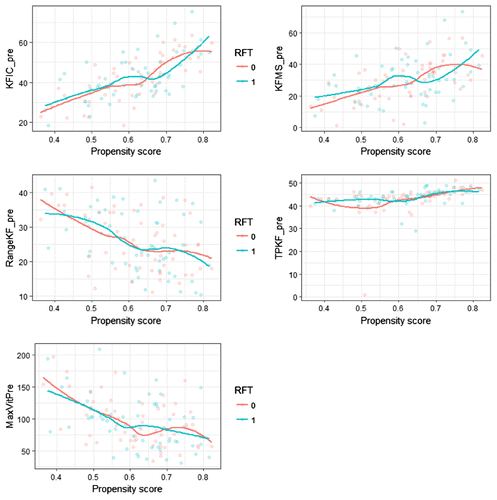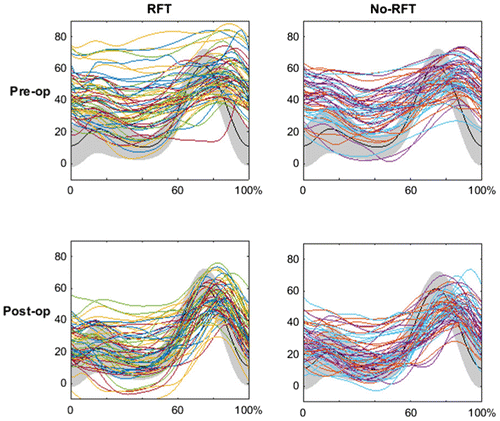1. Introduction
The rectus femoris transfer (RFT) as any musculotendinous transfer procedure has the specificity of having only a functional objective. In the context of single event multilevel surgery, it is associated to the surgical program with the aim to improve knee kinematics during swing phase. While many indicators have been introduced to describe knee ‘stiffness’ (this word is classically used to qualify a lack of knee flexion during swing phase and is not understood in this context as the actual biomechanical stiffness of the knee joint) and thus help to clarify RFT indication, most of the clinical studies are case series. Only one study with a randomized control group (Dreher et al., Citation2012) was conducted and although it highlights the positive effect of RFT, the relevance of this procedure remains controversial. Our objective in order to evaluate the effect of this gesture is to carry out an observational study with the creation of a control group by Propensity Score Matching. Our research question is to determine if the RFT is efficient at improving stiff knee gait and if it have a prophylactic benefit when the knee is not stiff.
2. Methods
151 children with cerebral palsy, operated with at least a clinical gait analysis before and after surgery are studied. Gait analysis were performed pre and postoperatively from 2004 to 2007 with a SAGA 3RT Biogesta system and since 2008 with a Vicon system. Lower limb marker placements were identical and kinematic data were computed with the same software based on a modified Helen Hayes (Davis III et al., 1991; Kadaba et al., Citation1990) model with anatomical markers on the femoral condyles and the medial-malleolus.
The lower limbs with a Goldberg index (Goldberg et al., Citation2006) quoted ‘Stiff’ or ‘Borderline’ are included. A RFT subgroup is matched to a No-RFT subgroup by Propensity Score Matching (Ho et al., Citation2007). The Propensity Score Matching is based on a logit model (caliper = 0.1, discard = ‘both’, m.order = ‘random’, method = ‘nearest’, MATCHIT package in R) built with multiple knee kinematics parameters (Knee Flexion at Initial Contact, Knee Flexion at Mid Stance, Knee Range of Motion, Timing to Peak Knee Flexion, Maximum Knee Flexion Velocity). The homogeneity of the samples is checked after pairing. The difference of the postoperative results between the two groups is studied on a set of kinematic variables by Student test.
A further analysis is carried out on ‘Non-Stiff’ patients to assess the possible prophylactic interest of RFT.
3. Results and discussion
The two subgroups are each composed of 57 lower limbs. No significant difference between the preoperative variables studied is present after pairing. The performance of the Propensity Score Matching can be graphically checked on Figure .
Figure 1 Graphs presenting for both groups of patients the values of the Propensity Score for each pre operative variables used in the matching (KFIC_pre: Knee Flexion at Initial Contact, KFMS_pre: Knee Flexion at Mid Stance, RangeKF_pre: Knee Range of Motion, TPKF_pre: Timing to Peak Knee Flexion, MaxVitPre: Maximum Knee Flexion Velocity). Each dot is a subject (RFT or NO-RTF). The locally weighted regression curves are given to facilitate the visual assessment of the matching performance. The different curves illustrate clearly that the different variables used to build the PSM model affect the propensity of being operated of a RFT.

The No-RFT group exhibited significant postoperative worsening of peak knee flexion in swing phase (No-RFT = 51 ° vs RFT = 57 °). The maximum knee flexion velocity is significantly greater after RFT (No-RFT = 130 ° / s vs RFT = 161 ° / s). For both subgroups, the knee kinematic signals are presented before and after surgery by Figure .
Figure 2 Mean Knee flexion extension angles (in degrees) of all the patients contituting the subgroup RFT and No-RFT after the Propensity Score Matching, before and after surgery. Data are normalized by gait cycle duration. The shaded area represent normative data.

The second evaluation focuses on two groups of 18 lower limbs. No differences were found on postoperative variables between those two ‘Non-Stiff’ groups.
4. Conclusions
The Propensity Score Matching approach is not a substitute for a randomized control trial but has the advantage of being able to be performed when ethical considerations make the randomization of surgical indications questionable. It then ensures a ‘comparability’ of the two groups with regard to the variables used. This study confirms (Goldberg et al., Citation2006; Thawrani et al., Citation2012) the interest of the RFT to improve some kinematic variables qualifying or even conditioning a good oscillation of the knee. The prophylactic indication of RFT does not seem to be relevant when the knee is ‘Non-Stiff’ preoperatively. This result corroborate previous one (Dreher et al., Citation2012) and may contribute to the current discussion of this question (Aiona et al., Citation2017).
Disclosure statement
No potential conflict of interest was reported by the authors.
Acknowledgements
This work was supported by the “Société d’Etudes et de Soins pour les Enfants Paralysés et polymalformés”.
References
- Aiona, M., Do, K.P., Feng, J., Jabur, M.. 2017. Comparison of Rectus Femoris Transfer Surgery Done Concomitant With Hamstring Lengthening or Delayed in Patients With Cerebral Palsy. J Pediatr Orthop. 37, 107–110.10.1097/BPO.0000000000000596
- Davis III, R.B., Õunpuu, S., Tyburski, D., Gage, J.R., 1991. A gait analysis data collection and reduction technique. Hum Mov Sci. 10, 575–587.10.1016/0167-9457(91)90046-Z
- Dreher, T., Götze, M., Wolf, S.I., Hagmann, S., Heitzmann, D., Gantz, S., Braatz, F.., 2012. Distal rectus femoris transfer as part of multilevel surgery in children with spastic diplegia – A randomized clinical trial. Gait Posture. 36, 212–218.10.1016/j.gaitpost.2012.02.017
- Goldberg, S.R., Ounpuu, S., Arnold, A.S., Gage, J.R., Delp, S.L.. 2006. Kinematic and kinetic factors that correlate with improved knee flexion following treatment for stiff-knee gait. J Biomech. 39, 689–698.10.1016/j.jbiomech.2005.01.015
- Ho, D.E., Imai, K., King, G., Stuart, E.A.. 2007., Matching as Nonparametric Preprocessing for Reducing Model Dependence in Parametric Causal Inference. Polit Anal. 15, 199–236.10.1093/pan/mpl013
- Kadaba, M.P., Ramakrishnan, H.K., Wootten, M.E., others, 1990. Measurement of lower extremity kinematics during level walking. J Orthop Res. 8, 383–392.10.1002/(ISSN)1554-527X
- Thawrani, D., Haumont, T., Church, C., Holmes, L., Dabney, K.W., Miller, F.. 2012. Rectus Femoris Transfer Improves Stiff Knee Gait in Children With Spastic Cerebral Palsy. Clin Orthop. 470, 1303–1311.10.1007/s11999-011-2215-1
